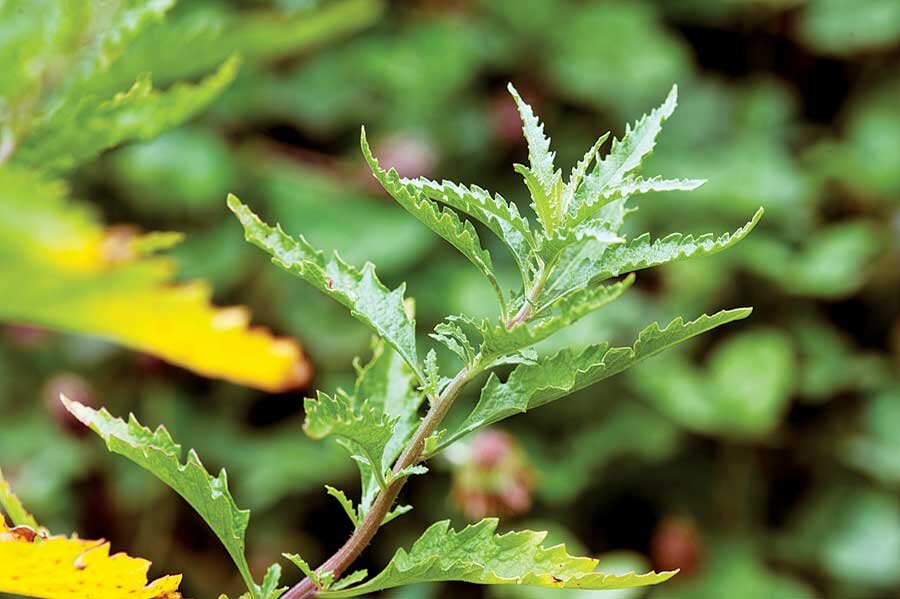Chenopodium ambrosioides

|
|
Dysphania ambrosioides Common Names: Wormseed, Mexican Tea, Epazote, Jesuits
Tea Scientific
Classification Kingdom: Plantae Phylum: Tracheophyta Class: Magnoliopsida Order: Caryophyllales Family: Amaranthaceae Genus: Dysphania Species: D. ambrosioides Synonyms: Chenopodium ambrosioides L., Ambrina ambrosioides (L.) Spach, Atriplex ambrosioides (L.) Crantz, Botrys ambrosioides (L.) Nieuwl., Orthosporum ambrosioides (L.) Kostel., Teloxys ambrosioides (L.) W.A.Weber Morphological Description Dysphania ambrosioides, commonly known as Wormseed or Epazote, is an annual or
short-lived perennial herb, typically growing 0.3–1.2 m tall, occasionally
reaching 2 m in fertile soils. Its key features include: · Stem: Erect, irregularly branched, green to reddish, covered with
aromatic glandular hairs, emitting a pungent, camphor-like odor when bruised · Leaves: Alternate, lanceolate to oblong, 2–12 cm long, 0.5–4 cm
wide, with serrated or toothed margins, aromatic, glossy green · Flowers: Small, green, 1–2 mm in diameter, in dense, spike-like
panicles at stem apices, hermaphroditic or unisexual · Fruit: Tiny utricles, enclosing single, glossy, dark brown to black
seeds, 0.6–1 mm in diameter The plant’s strong
aroma, due to essential oils rich in ascaridole, and its medicinal and culinary
uses make it significant in tropical regions. Distribution and Habitat Dysphania ambrosioides is native to Central and South America, likely originating
in Mexico, and has become a cosmopolitan weed, naturalized in Africa (Nigeria,
Ghana), Europe, Asia (India, China), Australia, and North America. It thrives
in: · Ecosystems: Disturbed areas, roadsides, agricultural fields, gardens,
and waste grounds · Climate: Tropical to warm temperate, with annual rainfall of
500–2,000 mm and temperatures of 15–35°C · Soils: Well-drained, sandy to loamy, tolerating nutrient-poor or
moderately saline conditions · Altitude: Sea level to 2,000 m In Nigeria, it is
widespread in southern states like Ogun and Lagos, often cultivated for
medicinal purposes or naturalized around villages. Its adaptability contributes
to its weedy nature.. Ethnopharmacology Dysphania ambrosioides Dysphania ambrosioides, formerly known as Chenopodium
ambrosioides and commonly called epazote or wormseed, is a medicinal plant
traditionally used in many parts of the world, especially in Central and South
America, Africa, and Asia. Its leaves, seeds, and essential oil are known for
anthelmintic (expelling parasitic worms), antimicrobial, antioxidant,
anti-inflammatory, antifungal, antispasmodic, and carminative (relieving gas)
properties. Traditionally, it has been used to treat intestinal parasites,
digestive disorders like bloating, flatulence, and indigestion, as well as
respiratory issues such as asthma and bronchitis. The essential oil, rich in
compounds like ascaridole, limonene, and p-cymene, is particularly potent but
must be used with caution due to its potential toxicity at high doses. Overall,
Dysphania ambrosioides is a powerful traditional remedy, but proper dosing is
crucial to avoid adverse effects, especially when using its concentrated oil. · Antioxidant
Activity: Dysphania ambrosioides
exhibits significant antioxidant properties, primarily due to its rich content
of phenolic compounds and flavonoids. A study evaluating the essential oils
from D. ambrosioides demonstrated strong antioxidant activity using DPPH and
β-carotene/linoleic acid assays, with an IC50 value of 12.5 µg/mL for DPPH
scavenging, attributed to compounds like ascaridole and carvacrol (Dagni et
al., 2022). Additionally, methanolic and ethyl acetate extracts of the aerial
parts showed potent free radical scavenging activity, with the methanolic
extract achieving up to 85% inhibition of DPPH radicals at 200 µg/mL,
reinforcing its potential as a natural antioxidant source (Elsayed et al.,
2025). · Antiparasitic
and Anthelmintic Activity:
Ascaridole, a major component in D. ambrosioides, showed in vitro and in vivo
activity against Entamoeba histolytica, with a 70% reduction in parasite load
in hamster models at 50 mg/kg, validating its use against amebiasis (Rodrigues
et al., 2023). Clinical trials have demonstrated its efficacy as an
anthelmintic, with a single dose of essential oil achieving a 90% cure rate
against intestinal nematodes in human subjects, supporting its traditional use
in treating parasitic infections (Panda et al., 2022). · Anti-inflammatory
and Analgesic Effects:
The anti-inflammatory activity of D. ambrosioides leaf extract was confirmed
using the human red blood cell membrane stabilization method, showing 68%
stabilization at 500 µg/mL, indicating its potential in managing inflammatory
conditions such as arthritis (Pangemanan et al., 2025). · Anticancer
Activity: Preclinical studies
have indicated that methanolic extracts of D. ambrosioides inhibit tumor growth
in breast cancer cell lines (MCF-7) by 45% at 100 µg/mL, suggesting its
potential as an anticancer agent through apoptosis induction (Ribeiro et al.,
2023). · Antidiabetic
and Vasorelaxant Effects:
Research has shown that D. ambrosioides extracts reduce blood glucose levels by
25% in streptozotocin-induced diabetic rats after 14 days of treatment and
induce vasorelaxation in rat aortic rings by 60% at 300 µg/mL, indicating
potential benefits in managing diabetes and hypertension (Kandsi et al., 2024). ⚠ Toxicity Profile: High doses of D. ambrosioides essential oil,
particularly due to ascaridole, can cause severe gastroenteritis, kidney and
liver damage, convulsions, and even death, with reported lethal doses in animal
models exceeding 1 g/kg (Wikipedia, n.d.). Studies have also reported potential
cytogenotoxic effects, with aqueous extracts inducing chromosomal aberrations
in human lymphocytes at concentrations above 500 µg/mL, highlighting the need
for cautious use (El-Bouzidi et al., 2024). Additional Uses · Culinary: Leaves are used as a flavoring in Mexican bean dishes,
soups, and stews, reducing flatulence, and in Nigerian soups for their pungent
aroma · Ecological Role: The plant’s allelopathic terpenes (e.g.,
ascaridole) inhibit nearby plant growth, making it a useful companion plant to
mask crop scents from pests in Nigeria. · Agricultural: Leaf extracts serve as biopesticides against Aedes aegypti larvae in Nigeria, leveraging ascaridole’s
larvicidal properties. References
External Links More Pictures
|
|
| Compounds of Chenopodium ambrosioides |
|
| References |